Long-Term Survival and Recurrence in Oropharyngeal Squamous Cell Carcinoma in Relation to Subsites, HPV, and p16-Status
Abstract
Simple Summary
Abstract
1. Introduction
2. Materials and Methods
2.1. Patients’ Characteristics
2.2. HPV-DNA and Overexpression of p16
2.3. Statistical and Survival Analysis
3. Results
3.1. Patient and Tumor Characteristics
3.2. Long-Term Overall Survival and Disease-Free Survival in Relation to p16 and Subsites
3.3. Localisation of Recurrence and Relation to Overexpression of p16 and Subsites
3.4. Long-Term Overall and Disease-Free Survival in Relation to Both Overexpression of p16 and Presence of HPV DNA, in Patients with TSCC/BOTSCC
3.5. HPV, p16 Status and Other Prognostic Factors in Patients with TSCC/BOTSCC
3.6. Survival after Recurrence TSCC/BOTSCC in Relation to HPV and Overexpression of p16
4. Discussion
5. Conclusions
Author Contributions
Funding
Institutional Review Board Statement
Informed Consent Statement
Data Availability Statement
Conflicts of Interest
References
- Syrjänen, K.J.; Syrjänen, S.M.; Lamberg, M.A.; Pyrhönen, S. Human papillomavirus (HPV) involvement in squamous cell lesions of the oral cavity. Proc. Finn. Dent. Soc. 1983, 79, 1–8. [Google Scholar]
- Chaturvedi, A.K.; Engels, E.A.; Pfeiffer, R.M.; Hernandez, B.Y.; Xiao, W.; Kim, E.; Jiang, B.; Goodman, M.T.; Sibug-Saber, M.; Cozen, W.; et al. Human papillomavirus and rising oropharyngeal cancer incidence in the United States. J. Clin. Oncol. 2011, 29, 4294–4301. [Google Scholar] [CrossRef] [PubMed]
- Marklund, L.; Hammarstedt, L. Impact of HPV in Oropharyngeal Cancer. J. Oncol. 2011, 2011, 509036. [Google Scholar] [CrossRef][Green Version]
- Mork, J.; Lie, A.K.; Glattre, E.; Hallmans, G.; Jellum, E.; Koskela, P.; Møller, B.; Pukkala, E.; Schiller, J.T.; Youngman, L.; et al. Human papillomavirus infection as a risk factor for squamous-cell carcinoma of the head and neck. N. Engl. J. Med. 2001, 344, 1125–1131. [Google Scholar] [CrossRef] [PubMed]
- Nasman, A.; Attner, P.; Hammarstedt, L.; Du, J.; Eriksson, M.; Giraud, G.; Ahrlund-Richter, S.; Marklund, L.; Romanitan, M.; Lindquist, D.; et al. Incidence of human papillomavirus (HPV) positive tonsillar carcinoma in Stockholm, Sweden: An epidemic of viral-induced carcinoma? Int. J. Cancer 2009, 125, 362–366. [Google Scholar] [CrossRef]
- Dahlgren, L.; Dahlstrand, H.M.; Lindquist, D.; Hogmo, A.; Bjornestal, L.; Lindholm, J.; Lundberg, B.; Dalianis, T.; Munck-Wikland, E. Human papillomavirus is more common in base of tongue than in mobile tongue cancer and is a favorable prognostic factor in base of tongue cancer patients. Int. J. Cancer 2004, 112, 1015–1019. [Google Scholar] [CrossRef]
- Rietbergen, M.M.; Leemans, C.R.; Bloemena, E.; Heideman, D.A.; Braakhuis, B.J.; Hesselink, A.T.; Witte, B.I.; de Jong, R.J.B.; Meijer, C.J.; Snijders, P.J.; et al. Increasing prevalence rates of HPV attributable oropharyngeal squamous cell carcinomas in the Netherlands as assessed by a validated test algorithm. Int. J. Cancer 2013, 132, 1565–1571. [Google Scholar] [CrossRef]
- Fakhry, C.; Westra, W.H.; Li, S.; Cmelak, A.; Ridge, J.A.; Pinto, H.; Forastiere, A.; Gillison, M.L. Improved survival of patients with human papillomavirus-positive head and neck squamous cell carcinoma in a prospective clinical trial. J. Natl. Cancer Inst. 2008, 100, 261–269. [Google Scholar] [CrossRef]
- Dahlstrand, H.; Näsman, A.; Romanitan, M.; Lindquist, D.; Ramqvist, T.; Dalianis, T. Human papillomavirus accounts both for increased incidence and better prognosis in tonsillar cancer. Anticancer Res. 2008, 28, 1133–1138. [Google Scholar]
- Nygård, M.; Aagnes, B.; Bray, F.; Møller, B.; Mork, J. Population-based evidence of increased survival in human papillomavirus-related head and neck cancer. Eur. J. Cancer 2012, 48, 1341–1346. [Google Scholar] [CrossRef]
- Sturgis, E.M.; Cinciripini, P.M. Trends in head and neck cancer incidence in relation to smoking prevalence: An emerging epidemic of human papillomavirus-associated cancers? Cancer 2007, 110, 1429–1435. [Google Scholar] [CrossRef] [PubMed]
- Marur, S.; D’Souza, G.; Westra, W.H.; Forastiere, A.A. HPV-associated head and neck cancer: A virus-related cancer epidemic. Lancet Oncol. 2010, 11, 781–789. [Google Scholar] [CrossRef]
- Smeets, S.J.; Hesselink, A.T.; Speel, E.J.; Haesevoets, A.; Snijders, P.J.; Pawlita, M.; Meijer, C.J.; Braakhuis, B.J.; Leemans, C.R.; Brakenhoff, R.H. A novel algorithm for reliable detection of human papillomavirus in paraffin embedded head and neck cancer specimen. Int. J. Cancer 2007, 121, 2465–2472. [Google Scholar] [CrossRef] [PubMed]
- Wagner, S.; Prigge, E.S.; Wuerdemann, N.; Reder, H.; Bushnak, A.; Sharma, S.J.; Obermueller, T.; von Knebel Doeberitz, M.; Dreyer, T.; Gattenlöhner, S.; et al. Evaluation of p16(INK4a) expression as a single marker to select patients with HPV-driven oropharyngeal cancers for treatment de-escalation. Br. J. Cancer 2020, 123, 1114–1122. [Google Scholar] [CrossRef]
- Dahlstrand, H.M.; Lindquist, D.; Björnestål, L.; Ohlsson, A.; Dalianis, T.; Munck-Wikland, E.; Elmberger, G. P16(INK4a) correlates to human papillomavirus presence, response to radiotherapy and clinical outcome in tonsillar carcinoma. Anticancer Res. 2005, 25, 4375–4383. [Google Scholar]
- Amin, M.B.; Edge, S.B.; Greene, F.; Byrd, D.R.; Brookland, R.K.; Washington, M.K.; Gershenwald, J.E.; Compton, C.C.; Hess, K.R.; Sullivan, D.C.; et al. AJCC Cancer Staging Manual, 8th ed.; Springer: Chicago, IL, USA, 2017. [Google Scholar]
- Haeggblom, L.; Ramqvist, T.; Tommasino, M.; Dalianis, T.; Nasman, A. Time to change perspectives on HPV in oropharyngeal cancer. A systematic review of HPV prevalence per oropharyngeal sub-site the last 3 years. Papillomavirus Res. 2017, 4, 1–11. [Google Scholar] [CrossRef]
- Marklund, L.; Holzhauser, S.; de Flon, C.; Zupancic, M.; Landin, D.; Kolev, A.; Haeggblom, L.; Munck-Wikland, E.; Hammarstedt-Nordenvall, L.; Dalianis, T.; et al. Survival of patients with oropharyngeal squamous cell carcinomas (OPSCC) in relation to TNM 8—Risk of incorrect downstaging of HPV-mediated non-tonsillar, non-base of tongue carcinomas. Eur. J. Cancer 2020, 139, 192–200. [Google Scholar] [CrossRef]
- Hammarstedt, L.; Holzhauser, S.; Zupancic, M.; Kapoulitsa, F.; Ursu, R.G.; Ramqvist, T.; Haeggblom, L.; Näsman, A.; Dalianis, T.; Marklund, L. The value of p16 and HPV DNA in non-tonsillar, non-base of tongue oropharyngeal cancer. Acta Otolaryngol. 2021, 141, 89–94. [Google Scholar] [CrossRef]
- Tham, T.; Wotman, M.; Roche, A.; Kraus, D.; Costantino, P. The prognostic effect of anatomic subsite in HPV-positive oropharyngeal squamous cell carcinoma. Am. J. Otolaryngol. 2019, 40, 567–572. [Google Scholar] [CrossRef]
- Gelwan, E.; Malm, I.J.; Khararjian, A.; Fakhry, C.; Bishop, J.A.; Westra, W.H. Nonuniform Distribution of High-risk Human Papillomavirus in Squamous Cell Carcinomas of the Oropharynx: Rethinking the Anatomic Boundaries of Oral and Oropharyngeal Carcinoma from an Oncologic HPV Perspective. Am. J. Surg. Pathol. 2017, 41, 1722–1728. [Google Scholar] [CrossRef]
- Ljokjel, B.; Lybak, S.; Haave, H.; Olofsson, J.; Vintermyr, O.K.; Aarstad, H.J. The impact of HPV infection on survival in a geographically defined cohort of oropharynx squamous cell carcinoma (OPSCC) patients in whom surgical treatment has been one main treatment. Acta Otolaryngol. 2014, 134, 636–645. [Google Scholar] [CrossRef] [PubMed]
- Garnaes, E.; Kiss, K.; Andersen, L.; Therkildsen, M.H.; Franzmann, M.B.; Filtenborg-Barnkob, B.; Hoegdall, E.; Krenk, L.; Josiassen, M.; Lajer, C.B.; et al. A high and increasing HPV prevalence in tonsillar cancers in Eastern Denmark, 2000–2010: The largest registry-based study to date. Int. J. Cancer 2015, 136, 2196–2203. [Google Scholar] [CrossRef] [PubMed]
- Haeggblom, L.; Attoff, T.; Hammarstedt-Nordenvall, L.; Nasman, A. Human papillomavirus and survival of patients per histological subsite of tonsillar squamous cell carcinoma. Cancer Med. 2018, 7, 1717–1722. [Google Scholar] [CrossRef] [PubMed]
- Gillison, M.L.; Trotti, A.M.; Harris, J.; Eisbruch, A.; Harari, P.M.; Adelstein, D.J.; Jordan, R.C.K.; Zhao, W.; Sturgis, E.M.; Burtness, B.; et al. Radiotherapy plus cetuximab or cisplatin in human papillomavirus-positive oropharyngeal cancer (NRG Oncology RTOG 1016): A randomised, multicentre, non-inferiority trial. Lancet 2019, 393, 40–50. [Google Scholar] [CrossRef]
- Christopherson, K.M.; Moreno, A.C.; Elgohari, B.; Gross, N.; Ferrarotto, R.; Mohamed, A.S.R.; Gunn, G.B.; Goepfert, R.P.; Mott, F.E.; Shah, S.J.; et al. Outcomes after salvage for HPV-positive recurrent oropharyngeal cancer treated with primary radiation. Oral Oncol. 2020, 113, 105125. [Google Scholar] [CrossRef] [PubMed]
- Trosman, S.J.; Koyfman, S.A.; Ward, M.C.; Al-Khudari, S.; Nwizu, T.; Greskovich, J.F.; Lamarre, E.D.; Scharpf, J.; Khan, M.J.; Lorenz, R.R.; et al. Effect of human papillomavirus on patterns of distant metastatic failure in oropharyngeal squamous cell carcinoma treated with chemoradiotherapy. JAMA Otolaryngol. Head Neck Surg. 2015, 141, 457–462. [Google Scholar] [CrossRef]
- Huang, S.H.; Perez-Ordonez, B.; Weinreb, I.; Hope, A.; Massey, C.; Waldron, J.N.; Kim, J.; Bayley, A.J.; Cummings, B.; Cho, B.C.; et al. Natural course of distant metastases following radiotherapy or chemoradiotherapy in HPV-related oropharyngeal cancer. Oral Oncol. 2013, 49, 79–85. [Google Scholar] [CrossRef]
- Guo, T.; Rettig, E.; Fakhry, C. Understanding the impact of survival and human papillomavirus tumor status on timing of recurrence in oropharyngeal squamous cell carcinoma. Oral Oncol. 2016, 52, 97–103. [Google Scholar] [CrossRef]
- O’Sullivan, B.; Adelstein, D.L.; Huang, S.H.; Koyfman, S.A.; Thorstad, W.; Hope, A.J.; Lewis, J.S., Jr.; Nussenbaum, B. First Site of Failure Analysis Incompletely Addresses Issues of Late and Unexpected Metastases in p16-Positive Oropharyngeal Cancer. J. Clin. Oncol. 2015, 33, 1707–1708. [Google Scholar] [CrossRef]
- Nasman, A.; Nordfors, C.; Holzhauser, S.; Vlastos, A.; Tertipis, N.; Hammar, U.; Hammarstedt-Nordenvall, L.; Marklund, L.; Munck-Wikland, E.; Ramqvist, T.; et al. Incidence of human papillomavirus positive tonsillar and base of tongue carcinoma: A stabilisation of an epidemic of viral induced carcinoma? Eur. J. Cancer 2015, 51, 55–61. [Google Scholar] [CrossRef]
- Marklund, L.; Näsman, A.; Ramqvist, T.; Dalianis, T.; Munck-Wikland, E.; Hammarstedt, L. Prevalence of human papillomavirus and survival in oropharyngeal cancer other than tonsil or base of tongue cancer. Cancer Med. 2012, 1, 82–88. [Google Scholar] [CrossRef] [PubMed]
- Lewis, J.S., Jr.; Beadle, B.; Bishop, J.A.; Chernock, R.D.; Colasacco, C.; Lacchetti, C.; Moncur, J.T.; Rocco, J.W.; Schwartz, M.R.; Seethala, R.R.; et al. Human Papillomavirus Testing in Head and Neck Carcinomas: Guideline from the College of American Pathologists. Arch. Pathol. Lab. Med. 2018, 142, 559–597. [Google Scholar] [CrossRef] [PubMed]
- Fakhry, C.; Zhang, Q.; Nguyen-Tan, P.F.; Rosenthal, D.; El-Naggar, A.; Garden, A.S.; Soulieres, D.; Trotti, A.; Avizonis, V.; Ridge, J.A.; et al. Human papillomavirus and overall survival after progression of oropharyngeal squamous cell carcinoma. J. Clin. Oncol. 2014, 32, 3365–3373. [Google Scholar] [CrossRef] [PubMed]
- Argiris, A.; Li, S.; Ghebremichael, M.; Egloff, A.M.; Wang, L.; Forastiere, A.A.; Burtness, B.; Mehra, R. Prognostic significance of human papillomavirus in recurrent or metastatic head and neck cancer: An analysis of Eastern Cooperative Oncology Group trials. Ann. Oncol. 2014, 25, 1410–1416. [Google Scholar] [CrossRef] [PubMed]
- Culié, D.; Viotti, J.; Modesto, A.; Schiappa, R.; Chamorey, E.; Dassonville, O.; Poissonnet, G.; Guelfucci, B.; Bizeau, A.; Vergez, S.; et al. Upfront surgery or definitive radiotherapy for patients with p16-negative oropharyngeal squamous cell carcinoma. A GETTEC multicentric study. Eur. J. Surg. Oncol. 2021, 47, 367–374. [Google Scholar] [CrossRef]
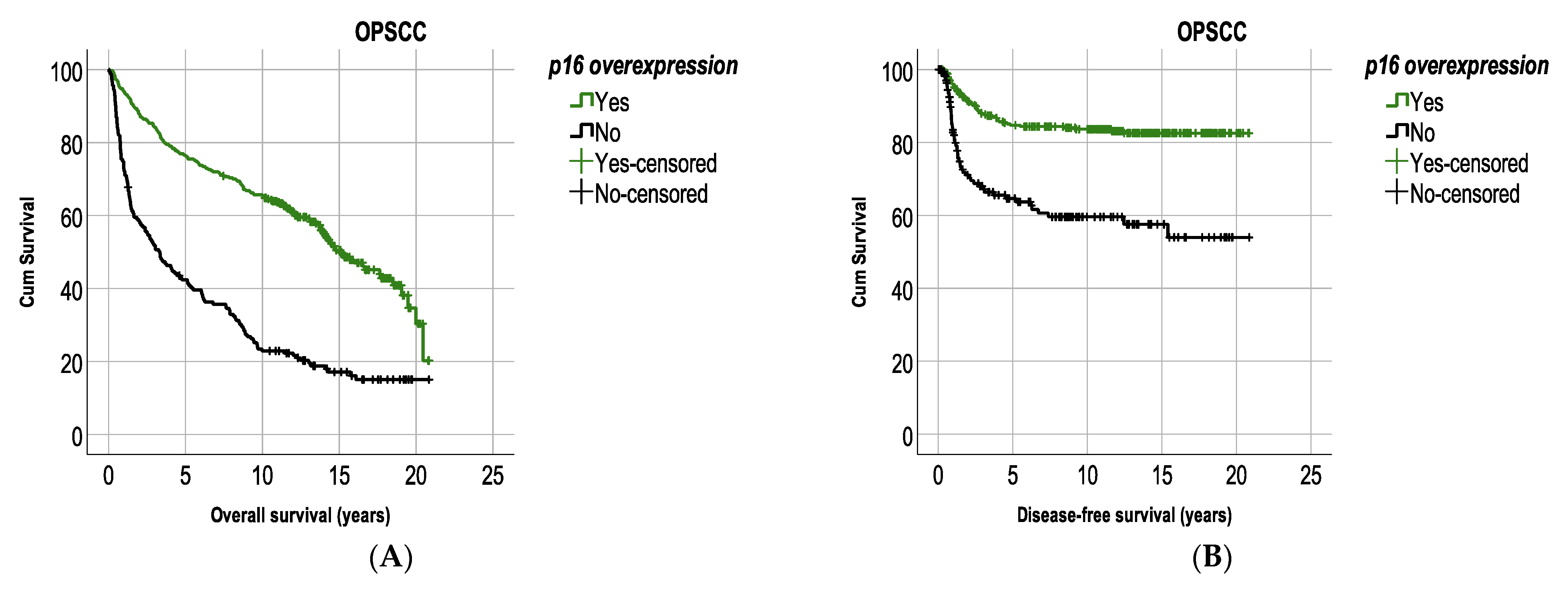
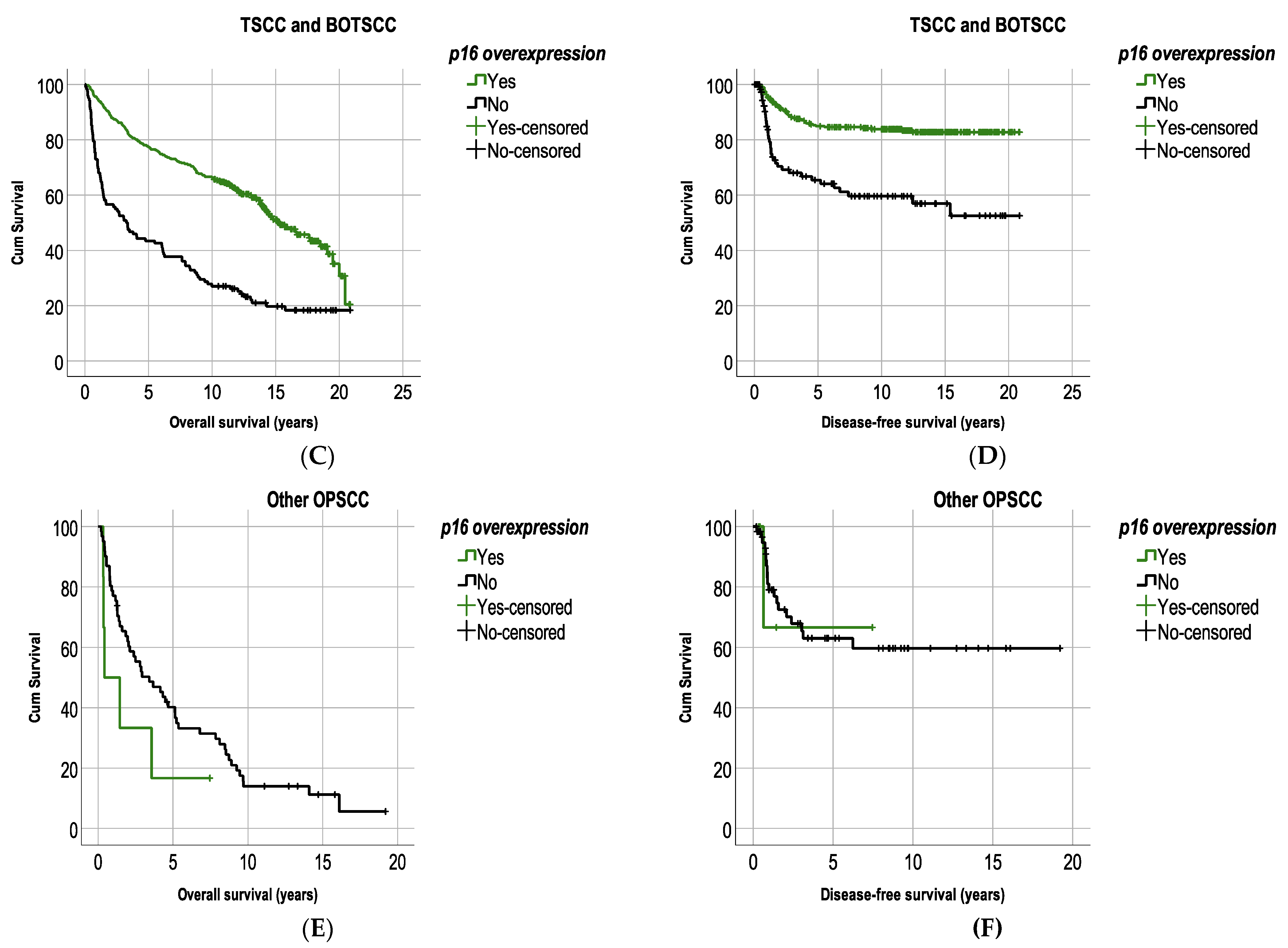
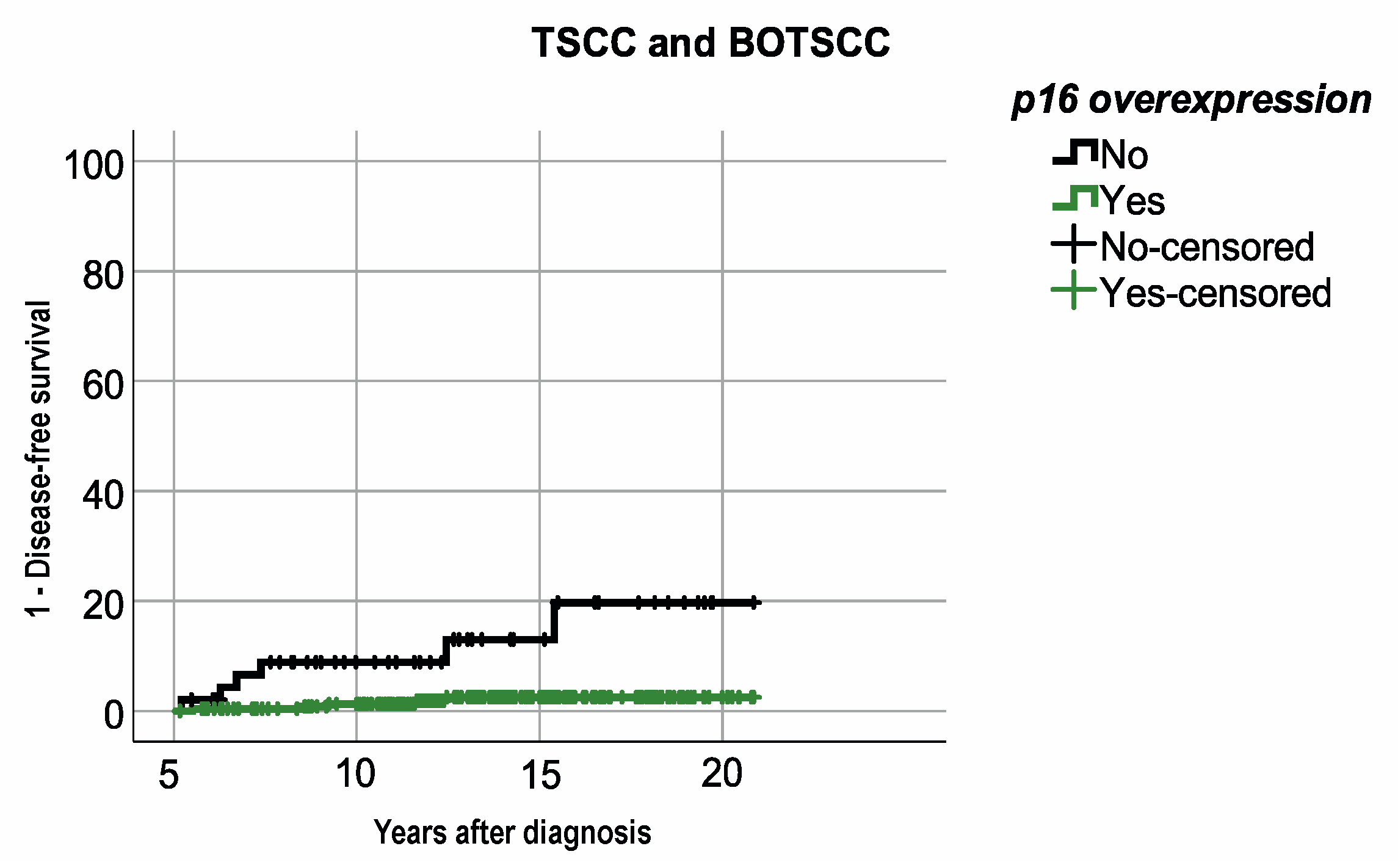
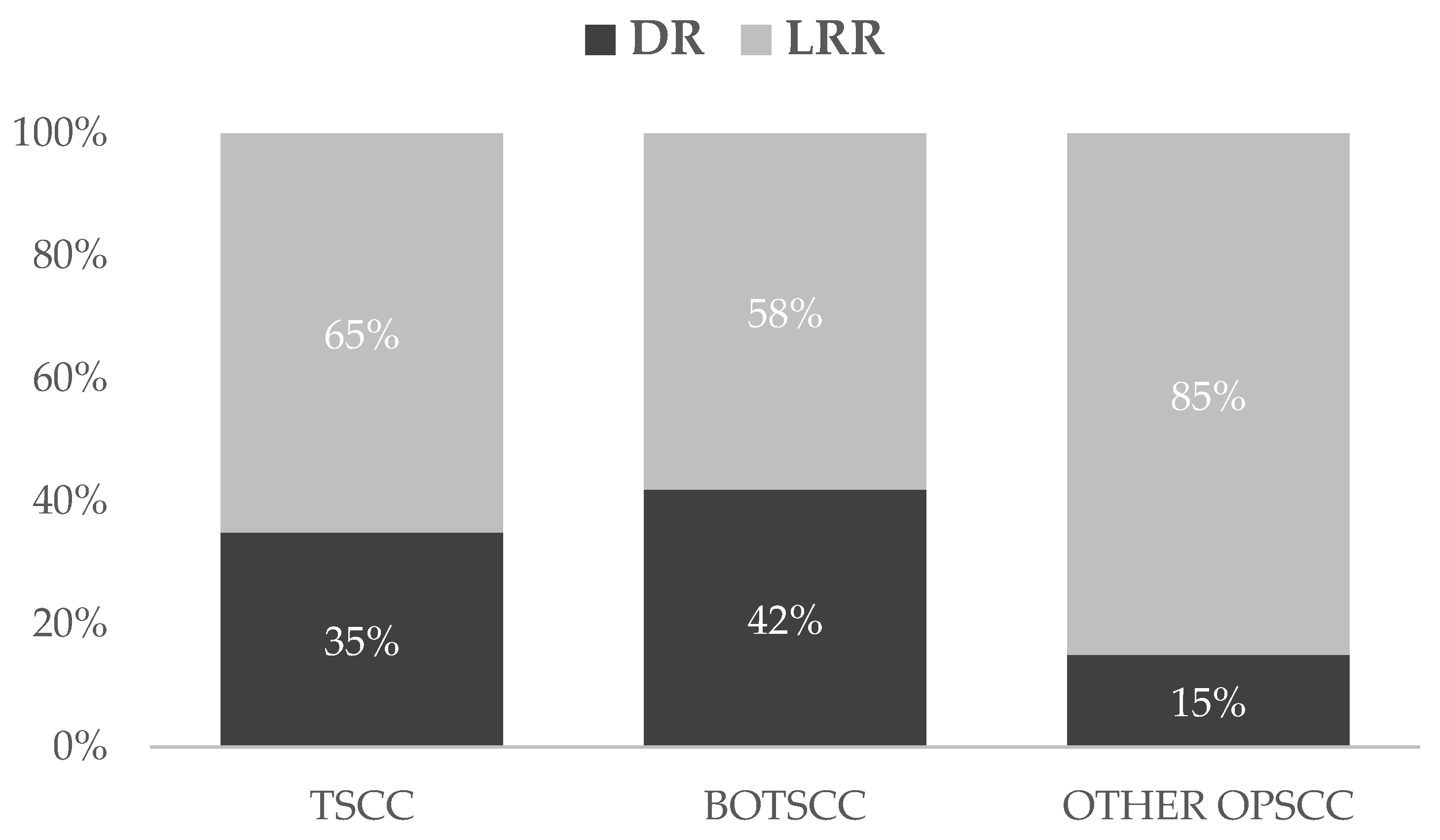
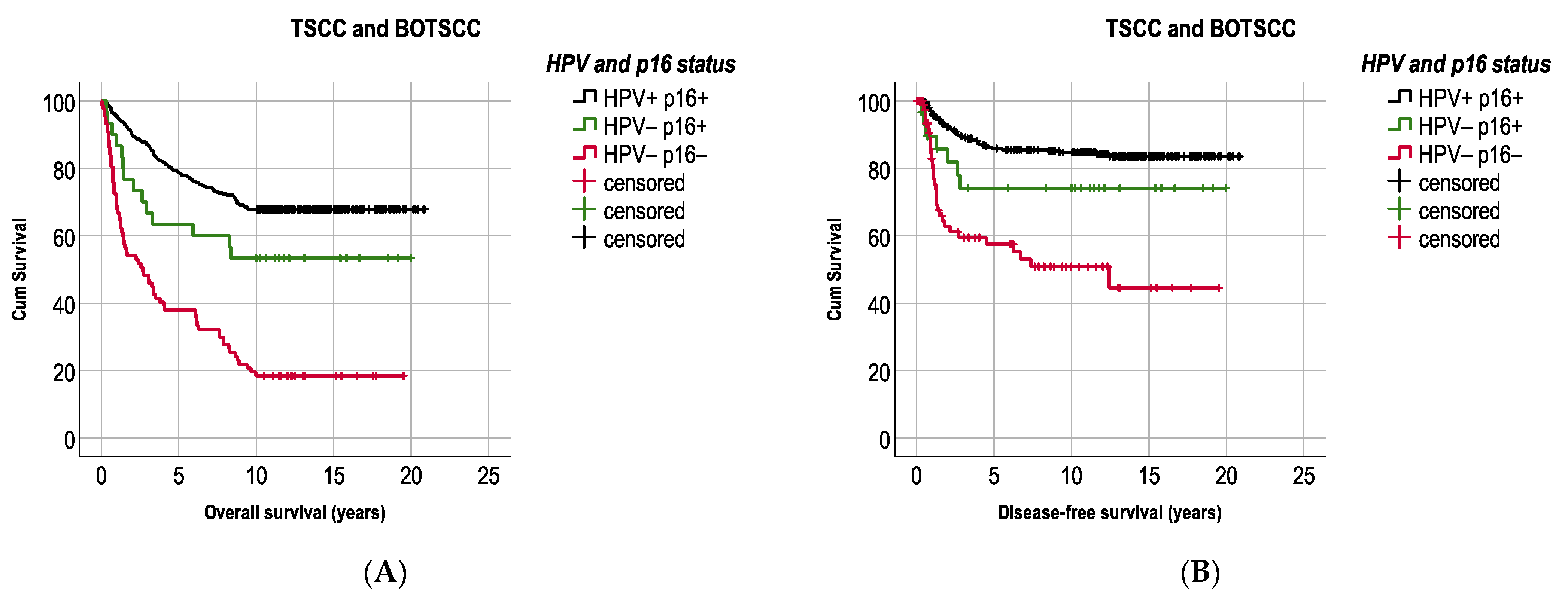
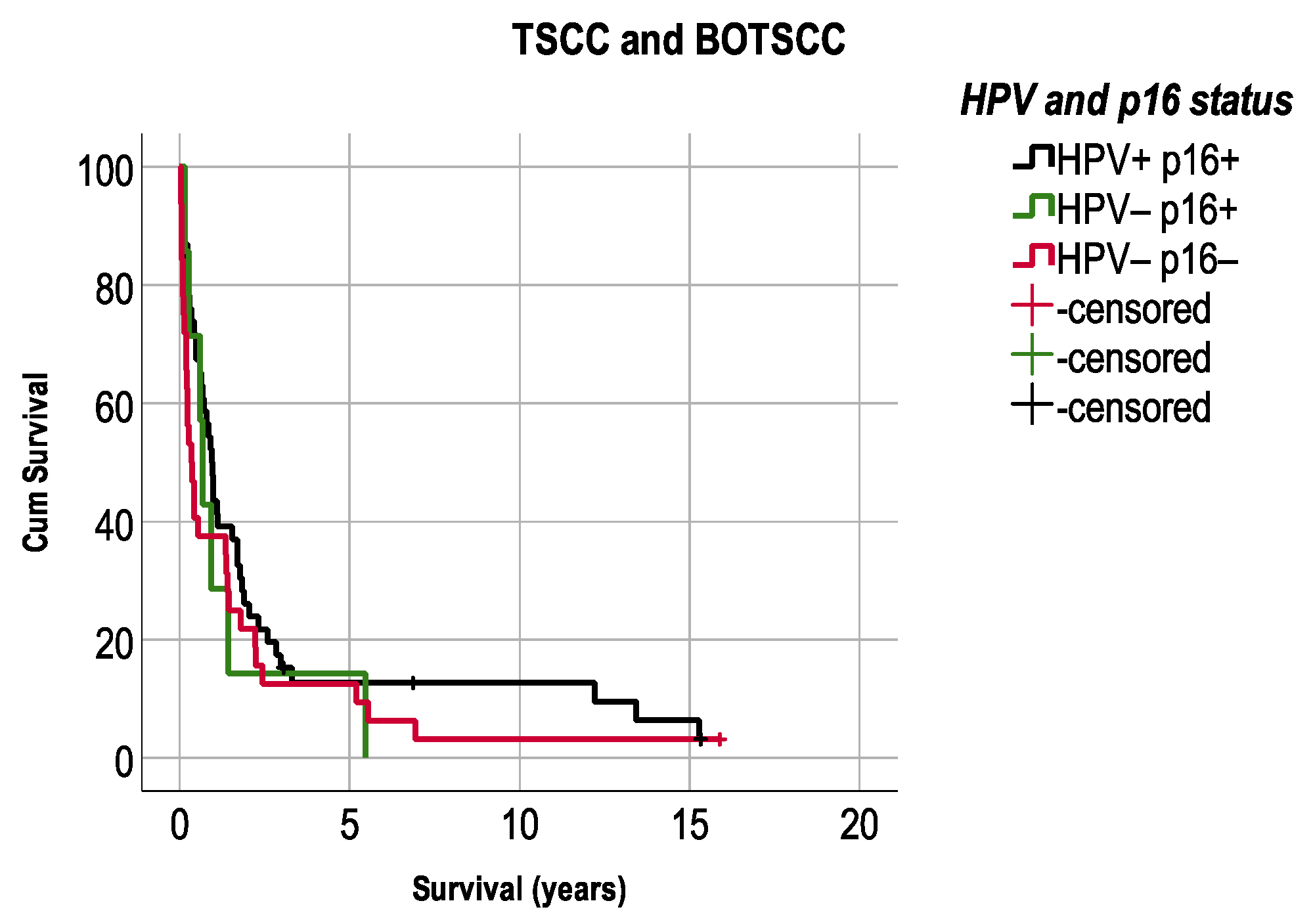
| TSCC (%) | BOTSCC (%) | OtherOPSCC (%) | Total (%) | ||
|---|---|---|---|---|---|
| Number of patients | 337 | 126 | 66 | 529 | |
| Age | Mean | 60.4 | 62 | 65.2 | 61 |
| Median | 59 | 62 | 65 | 61 | |
| Range | 29–90 | 30–84 | 46–88 | 29–90 | |
| Sex | Female | 82 (24%) | 39 (31%) | 23 (35%) | 144 (27%) |
| Male | 255 (76%) | 87 (69%) | 43 (65%) | 385 (73%) | |
| T | T1 | 78 (23%) | 40 (32%) | 8 (12%) | 126 (24%) |
| (AJCC 7th Edition) | T2 | 129 (38%) | 33 (26%) | 24 (36%) | 186 (35%) |
| T3 | 70 (21%) | 17 (13%) | 25 (38%) | 112 (21%) | |
| T4a | 56 (17%) | 36 (29%) | 7 (11%) | 99 (19%) | |
| T4b | 4 (1%) | 0 (0%) | 2 (3%) | 6 (1%) | |
| N | N0 | 70 (21%) | 28 (22%) | 29 (44%) | 127 (24%) |
| (AJCC 7th Edition) | N1 | 72 (21%) | 16 (13%) | 12 (18%) | 100 (19%) |
| N2a | 49 (15%) | 13 (10%) | 4 (6%) | 66 (12%) | |
| N2b | 112 (33%) | 32 (25%) | 9 (14%) | 153 (29%) | |
| N2c | 21 (6%) | 27 (21%) | 11 (17%) | 59 (11%) | |
| N3 | 13 (4%) | 7 (6%) | 1 (2%) | 21 (4%) | |
| NX | 0 (0%) | 3 (2%) | 1 (2%) | 3 (1%) | |
| M | M0 | 335 (99%) | 120 (95%) | 63 (95%) | 518 (98%) |
| (AJCC 7th Edition) | M1 | 2 (1%) | 2 (2%) | 0 (0%) | 4 (1%) |
| MX | 0 (0%) | 4 (3%) | 3 (5%) | 7 (1%) | |
| TNM Stage | I | 10 (3%) | 8 (6%) | 3 (21%) | 21 (4%) |
| (AJCC 7th Edition) | II | 25 (7%) | 7 (6%) | 12 (21%) | 44 (8%) |
| III | 83 (25%) | 20 (16%) | 23 (15%) | 126 (24%) | |
| IVa | 198 (59%) | 82 (65%) | 25 (33%) | 305 (58%) | |
| IVb | 19 (6%) | 7 (6%) | 3 (6%) | 29 (5%) | |
| IVc | 2 (1%) | 2 (2%) | 0 (4%) | 4 (1%) | |
| Smoking | Ever | 237 (70%) | 79 (63%) | 51 (77%) | 367 (69%) |
| Never | 92 (27%) | 43 (34%) | 7 (11%) | 142 (27%) | |
| Not known | 8 (2%) | 4 (3%) | 4 (6%) | 20 (4%) | |
| p16 overexpression | No | 81 (24%) | 41 (33%) | 60 (91%) | 182 (34%) |
| Yes | 256 (76%) | 85 (67%) | 6 (9%) | 347 (66%) | |
| HPV DNA status | Negative | 78 (23%) | 39 (31%) | 47 (71%) | 164 (31%) |
| Positive | 259 (77%) | 87 (69%) | 15 (23%) | 361 (68%) | |
| Not known | 0 (0%) | 0 (0%) | 4 (6%) | 4 (1%) | |
| Performance status | 0 | 304 (90%) | 102 (81%) | 27 (41%) | 433 (82%) |
| (WHO/ECOG) | 1 | 20 (6%) | 19 (15%) | 20 (30%) | 59 (11%) |
| 2 | 7 (2%) | 5 (4%) | 16 (24%) | 28 (5%) | |
| 3 | 5 (1%) | 0 (0%) | 3 (5%) | 8 (2%) | |
| Not known | 1 (0%) | 0 (0%) | 0 (0%) | 1 (0%) | |
| Treatment 1 | RT | 234 (69%) | 56 (44%) | 48 (73%) | 340 (64%) |
| CRT | 101 (30%) | 70 (56%) | 17 (26%) | 183 (35%) | |
| Primary surgery | 2 (1%) | 0 (0%) | 4 (6%) | 6 (1%) | |
| Recurrence | Yes | 61 (18%) | 30 (24%) | 19 (29%) | 110 (21%) |
| No | 276 (82%) | 96 (76%) | 47 (71%) | 419 (79%) |
| Overall Survival (OS) | Disease-Free Survival (DFS) | ||||||||||||
|---|---|---|---|---|---|---|---|---|---|---|---|---|---|
| Univariable | Multivariable | Univariable | Multivariable | ||||||||||
| HR | 95% CI | p-Value | HR | 95% CI | p-Value | HR | 95% CI | p | HR | 95% CI | p | ||
| HPV/p16 status | HPV− p16− | 1 | 1 | 1 | 1 | ||||||||
| HPV− p16+ | 0.31 | 0.15–0.66 | 0.002 | 0.49 | 0.23–1.05 | 0.07 | 0.34 | 0.12–0.98 | 0.05 | 0.43 | 0.15–1.3 | 0.1 | |
| HPV+ p16+ | 0.23 | 0.17–0.34 | <0.0001 | 0.30 | 0.21–0.44 | <0.0001 | 0.25 | 0.15–0.42 | <0.0001 | 0.29 | 0.17–0.50 | <0.0001 | |
| Age | 1.06 | 1.05–1.09 | <0.0001 | 1.1 | 1.04–1.08 | <0.0001 | 1.04 | 1.02–1.06 | 0.001 | 1.03 | 1.008–1.06 | 0.009 | |
| Smoking | Ever | 1 | 1 | 1 | 1 | ||||||||
| Never | 0.46 | 0.30–0.68 | <0.0001 | 0.58 | 0.38–0.88 | 0.01 | 0.54 | 0.31–0.93 | 0.03 | 0.69 | 0.39–1.3 | 0.2 | |
| Stage (TNM-7) | I/II | 1 | 1 | 1 | 1 | ||||||||
| III/IV | 1.12 | 0.66–1.9 | 0.7 | 1.6 | 0.93–2.8 | 0.09 | 1.36 | 0.59–3.1 | 0.5 | 1.8 | 0.78–4.3 | 0.2 | |
Publisher’s Note: MDPI stays neutral with regard to jurisdictional claims in published maps and institutional affiliations. |
© 2021 by the authors. Licensee MDPI, Basel, Switzerland. This article is an open access article distributed under the terms and conditions of the Creative Commons Attribution (CC BY) license (https://creativecommons.org/licenses/by/4.0/).
Share and Cite
Wendt, M.; Hammarstedt-Nordenvall, L.; Zupancic, M.; Friesland, S.; Landin, D.; Munck-Wikland, E.; Dalianis, T.; Näsman, A.; Marklund, L. Long-Term Survival and Recurrence in Oropharyngeal Squamous Cell Carcinoma in Relation to Subsites, HPV, and p16-Status. Cancers 2021, 13, 2553. https://doi.org/10.3390/cancers13112553
Wendt M, Hammarstedt-Nordenvall L, Zupancic M, Friesland S, Landin D, Munck-Wikland E, Dalianis T, Näsman A, Marklund L. Long-Term Survival and Recurrence in Oropharyngeal Squamous Cell Carcinoma in Relation to Subsites, HPV, and p16-Status. Cancers. 2021; 13(11):2553. https://doi.org/10.3390/cancers13112553
Chicago/Turabian StyleWendt, Malin, Lalle Hammarstedt-Nordenvall, Mark Zupancic, Signe Friesland, David Landin, Eva Munck-Wikland, Tina Dalianis, Anders Näsman, and Linda Marklund. 2021. "Long-Term Survival and Recurrence in Oropharyngeal Squamous Cell Carcinoma in Relation to Subsites, HPV, and p16-Status" Cancers 13, no. 11: 2553. https://doi.org/10.3390/cancers13112553
APA StyleWendt, M., Hammarstedt-Nordenvall, L., Zupancic, M., Friesland, S., Landin, D., Munck-Wikland, E., Dalianis, T., Näsman, A., & Marklund, L. (2021). Long-Term Survival and Recurrence in Oropharyngeal Squamous Cell Carcinoma in Relation to Subsites, HPV, and p16-Status. Cancers, 13(11), 2553. https://doi.org/10.3390/cancers13112553








